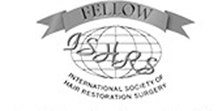Jeremy Piven’s Hair Transplant Donor Scars
Unfortunately, bad hair transplants make everyone fearful. Bad scars are no exception. This photograph of Jeremy Piven’s scar (the actor from Entourage) has certainly raised quite a bit of attention. It compels me to write about why good harvesting techniques should avoid a scar that looks as bad as his does. Although one cannot shave his head completely after a hair transplant, the scars should look significantly better than what is shown in this photograph. In fact, it is oftentimes very difficult to see my scars even close up after a hair transplant procedure. I would like to take this blog article to discuss the principles of good donor scar creation.
- Selecting the right patient and timing to do the procedure. If the individual recently had a hair transplant and the area is relatively tight, I would not perform another hair transplant soon. In general, I like to wait about a year before considering having a procedure performed. Also, I would recommend donor relaxation exercises to soften the scalp in preparation for harvesting.
- Harvesting only a thin width of donor strip. I almost never harvest over a centimeter of donor hair so that there is no tension on the wound at closure time. Some outfits like to do megasessions in which 2 to 3 cm of donor hair is removed. I personally think this risks a bad scar. By taking this much tissue out at once it can compromise the result in the donor area, which to me is as important as the transplanted result.
- A good donor harvest leads to a good donor scar. Starting with tumescence, which is a fluid injected at the beginning of the donor harvest, the hair follicles are straightened out and the nerve and blood supply are protected. I believe truly that this is the most important step in leading to a good donor scar. When the hairs are transected (cut and destroyed) during a harvest, the wound heals poorly. In addition, I strive to protect every single minor blood vessel so that the wound heals exceptionally well, and I do that in every case.
- A two-layered closure. To me, this has become the gold standard of wound closing. When I take tension off of the skin, the wound heals really well and does not widen. Even for months as that deeper suture begins to dissolve the wound is held perfectly together without spreading wide.
- A trichophytic closure when appropriate. When the wound has zero tension on it, I perform a so-called trichophytic closure, which is taking 1 mm of skin off the bottom lip of the wound so that the hairs grow seamlessly through the scar, making the scar in many cases virtually invisible. (View Dr Lam’s post “Understanding the Role of the Trichophytic Closure in Hair Transplants”).
- Using perfectly aligned sutures and not staples. As you can see with Jeremy Piven’s scar, the wound was not aligned well. It is important that sutures be used over staples for the least discomfort afterward but in my opinion for better wound alignment. It does take significantly more time to perform but in my opinion it is truly worth it.
Samuel M. Lam, MD, FACS is a board certified hair transplant surgeon in Dallas, Texas. To learn more about Dr Lam’s hair transplant procedures please visit our website hairtx.com or call 972-312-8105 to schedule a consultation.




